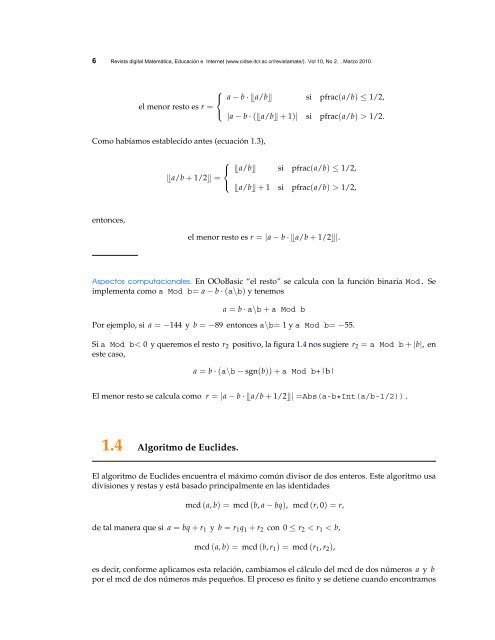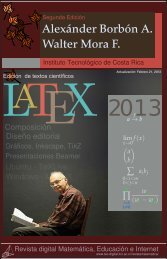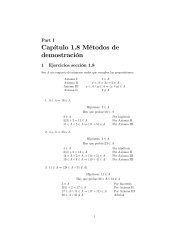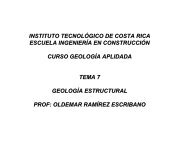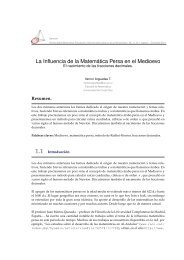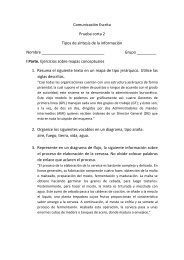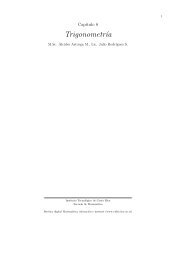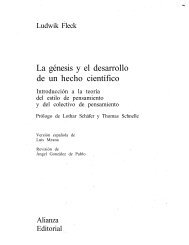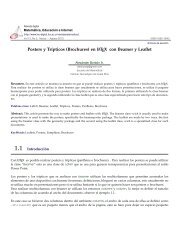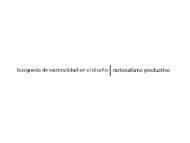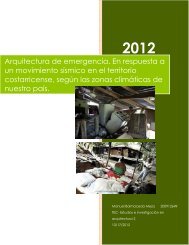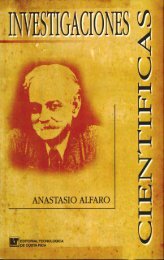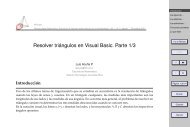1.5 Algoritmo de Euclides con menor resto. - TEC-Digital
1.5 Algoritmo de Euclides con menor resto. - TEC-Digital
1.5 Algoritmo de Euclides con menor resto. - TEC-Digital
Create successful ePaper yourself
Turn your PDF publications into a flip-book with our unique Google optimized e-Paper software.
6 Revista digital Matemática, Educación e Internet (www.cidse.itcr.ac.cr/revistamate/). Vol 10, No 2. , Marzo 2010.<br />
⎧<br />
⎨ a − b · �a/b� si pfrac(a/b) ≤ 1/2,<br />
el <strong>menor</strong> <strong>resto</strong> es r =<br />
⎩<br />
|a − b · (�a/b� + 1)| si pfrac(a/b) > 1/2.<br />
Como habíamos establecido antes (ecuación 1.3),<br />
entonces,<br />
⎧<br />
⎨ �a/b� si pfrac(a/b) ≤ 1/2,<br />
�a/b + 1/2� =<br />
⎩<br />
�a/b� + 1 si pfrac(a/b) > 1/2,<br />
el <strong>menor</strong> <strong>resto</strong> es r = |a − b · �a/b + 1/2�|.<br />
Aspectos computacionales. En OOoBasic “el <strong>resto</strong>” se calcula <strong>con</strong> la función binaria Mod. Se<br />
implementa como a Mod b= a − b · (a\b) y tenemos<br />
a = b · a\b + a Mod b<br />
Por ejemplo, si a = −144 y b = −89 entonces a\b= 1 y a Mod b= −55.<br />
Si a Mod b< 0 y queremos el <strong>resto</strong> r2 positivo, la figura 1.4 nos sugiere r2 = a Mod b + |b|, en<br />
este caso,<br />
a = b · (a\b − sgn(b)) + a Mod b+|b|<br />
El <strong>menor</strong> <strong>resto</strong> se calcula como r = |a − b · �a/b + 1/2�| =Abs(a-b*Int(a/b-1/2)).<br />
1.4 <strong>Algoritmo</strong> <strong>de</strong> Eucli<strong>de</strong>s.<br />
El algoritmo <strong>de</strong> Eucli<strong>de</strong>s encuentra el máximo común divisor <strong>de</strong> dos enteros. Este algoritmo usa<br />
divisiones y restas y está basado principalmente en las i<strong>de</strong>ntida<strong>de</strong>s<br />
mcd (a, b) = mcd (b, a − bq), mcd (r, 0) = r,<br />
<strong>de</strong> tal manera que si a = bq + r1 y b = r1q1 + r2 <strong>con</strong> 0 ≤ r2 < r1 < b,<br />
mcd (a, b) = mcd (b, r1) = mcd (r1, r2),<br />
es <strong>de</strong>cir, <strong>con</strong>forme aplicamos esta relación, cambiamos el cálculo <strong>de</strong>l mcd <strong>de</strong> dos números a y b<br />
por el mcd <strong>de</strong> dos números más pequeños. El proceso es finito y se <strong>de</strong>tiene cuando en<strong>con</strong>tramos


